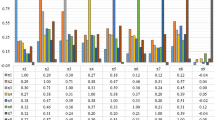Abstract
In recent years, computational diagnostic tools and artificial intelligence techniques provide automated procedures for objective judgments by making use of quantitative measures and machine learning techniques. In this paper we propose a Support Vector Machines (SVMs) based classifier in comparison with Bayesian classifiers and Artificial Neural Networks for the prognosis and diagnosis of breast cancer disease. The paper provides the implementation details along with the corresponding results for all the assessed classifiers. Several comparative studies have been carried out concerning both the prognosis and diagnosis problem demonstrating the superiority of the proposed SVM algorithm in terms of sensitivity, specificity and accuracy.
Similar content being viewed by others
References
Estimated new cancer cases and deaths for 2005. http://seer.cancer.gov/cgi-bin/csr
Mangasarian et al. (1995) Breast cancer diagnosis and prognosis via linear programming. Oper Res 43(4):570–577
Burke HB, Goodman PH et al. (1997) Artificial neural networks improve the accuracy of cancer survival prediction. Cancer 79:857–862
Choong PL, de Silva CJS et al. (1996) Entropy maximization networks, an application to breast cancer prognosis. IEEE Trans Neural Netw 7(3):568–577
Street WN (1998) A neural network model for prognostic prediction. In: Proceedings of the fifteenth international conference on machine learning, Madison, WI. Kaufmann, Los Altos
Perner P, Holt A, Richter M (2005) Image processing in case-based reasoning. Knowl Eng Rev 20(3):311–314
Maintz J, Viergever M (1998) A survey of medical image registration. Med Image Anal 2(1):1–16
Tsotsos J (1985) Knowledge organization and its role in representation and interpretation for time-varying data: the ALVEN system. Comput Intell 1(1):16–32
Martelli A (1976) An application of heuristic search methods to edge and contour detection. Commun ACM 19:73–83
McInerney T, Terzopoulos D (1996) Deformable models in medical image analysis: a survey. Med Image Anal 1(2):91–108
Metaxas D, Terzopoulos D (1991) In: Medioni G, Horn B (eds) Constrained deformable superquadrics and nonrigid motion tracking, computer vision and pattern Recognition. IEEE Computer Society, Los Alamitos, pp 337–343
Staib L, Duncan J (1996) Model-based deformable surface finding for medical images. IEEE Trans Med Imaging 78(5):720–731
Bocchi L, Nori J (2007) Shape analysis of microcalcifications using Radon transform. Med Eng Phys 29(6):691–698
Amores J, Radeva P (2005) Registration and retrieval of highly elastic bodies using contextual information. Pattern Recognit Lett 26(11):1720–1731
Antani Sameer, Lee DJ, Long LR, Thoma GR, (2004) Evaluation of shape similarity measurement methods for spine X-ray images. J Vis Commun Image Represent 15(3):285–302
Zapater V, Martinez-Costa L, Ayala G (2002) Classifying human endothelial cells based on individual granulometric size distributions. Image Vis Comput 20(11):783–791
Martens H, Thybo AK, Andersen HJ, Karlsson AH, Donstrup S, Stodkilde-Jorgensen H, Martens M (2002) Sensory analysis for magnetic resonance-image analysis: using human perception and cognition to segment and assess the interior of potatoes. Lebensm Wiss Technol 35(1):70–79
Maglogiannis I, Pavlopoulos S, Koutsouris D (2005) An integrated computer supported acquisition, handling and characterization system for pigmented skin lesions in dermatological images. IEEE Trans Inf Technol Biomed 9(1):86–98
Morris D (1988) An evaluation of the use of texture measures for tissue characterization of ultrasound images of in vivo human placenta. Ultrasound Med Biol 14(1):387–395
Doukas C, Maglogiannis I, Chatzioannou A, Papapetropoulos C (2006) Automated angiogenesis quantification through advanced image processing techniques. In: Proceedings of the 28th IEEE engineering in medicine and biology conference, EMBC 2006, pp 2345–2348
Anagnostopoulos, Anagnostopoulos C, Vergados D, Rouskas A, Kormentzas G (2006) The Wisconsin breast cancer problem: diagnosis and TTR/DFS time prognosis using probabilistic and generalised regression information classifiers. Oncol Rep, special issue Computational analysis and decision support systems in oncology 15:975–982
Wolberg WH, Street WN, Heisey DM, Mangasarian OL (1995) Computer-derived nuclear features distinguish malignant from benign breast cytology. Hum Pathol 26:792–796
Tourassi GD, Markey MK, Lo JY, Floyd CE Jr (2001) A neural network approach to breast cancer diagnosis as a constraint satisfaction problem. Med Phys 28:804–811
Wolberg WH, Street WN, Heisey DM, Mangasarian OL (1995) Computer-derived nuclear features distinguish malignant from benign breast cytology. Hum Pathol 26:792–796
Wolberg WH, Street WN, Mangasarian OL (1994) Machine learning techniques to diagnose breast cancer from fine-needle aspirates. Cancer Lett 77:163–171
Wolberg WH, Street WN, Mangasarian OL (1995) Image analysis and machine learning applied to breast cancer diagnosis and prognosis. Anal Quant Cytol Histol 17(2):77–87
Hoya T, Chambers JA (2001) Heuristic pattern correction scheme using adaptively trained generalized regression neural networks. IEEE Trans Neural Netw 12(1):91–100
Kaban A, Girolami M (2000) Initialized and guided EM-clustering of sparse binary data with application to text based documents. In: 15th international conference on pattern recognition, vol 2, September 2000, pp 744–747
Anagnostopoulos I, Anagnostopoulos C, Loumos V, Kayafas E (2004) Classifying web pages employing a probabilistic neural network classifier. IEE Proc Softw 151(3):139–150
Burges C. A tutorial on support vector machines for pattern recognition. http://www.kernel-machines.org/
Schölkopf B. Statistical learning and kernel methods. http://research.Microsoft.com/~bsc
Campbell C. Kernel methods: a survey of current techniques. http://www.kernel-machines.org/
Maglogiannis IG, Zafiropoulos EP (2004) Characterization of digital medical images utilizing support vector machines. BMC Med Inform Decis Mak 4:4
Duan KB, Keerthi SS (2005) Which is the best multiclass SVM method? In: Oza NC et al (eds) An empirical study, MCS 2005. Lecture notes in computer science, vol 3541, pp 278–285
Lee Y, Lee C-K (2003) Classification of multiple cancer types by multicategory support vector machines using gene expression data. Bioinformatics 19(9):1132–1139
Witten IH, Frank E (2005) Data mining: practical machine learning tools and techniques, 2nd ed. Kaufmann, Los Altos
Specht DF (1990) Probabilistic neural networks. Neural Netw 3(1), 109–118
Specht DF (1996) Probabilistic neural networks and general regression neural networks. In: Chen CH (ed) Fuzzy logic and neural network handbook. McGraw-Hill, New York
Masters T (1995) Advanced algorithms for neural networks. Wiley, New York
University of Waikato. Weka software. Available at http://www.cs.waikato.ac.nz/
Author information
Authors and Affiliations
Corresponding author
Rights and permissions
About this article
Cite this article
Maglogiannis, I., Zafiropoulos, E. & Anagnostopoulos, I. An intelligent system for automated breast cancer diagnosis and prognosis using SVM based classifiers. Appl Intell 30, 24–36 (2009). https://doi.org/10.1007/s10489-007-0073-z
Received:
Accepted:
Published:
Issue Date:
DOI: https://doi.org/10.1007/s10489-007-0073-z




